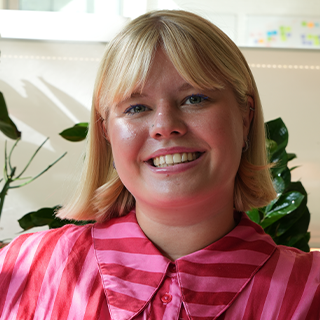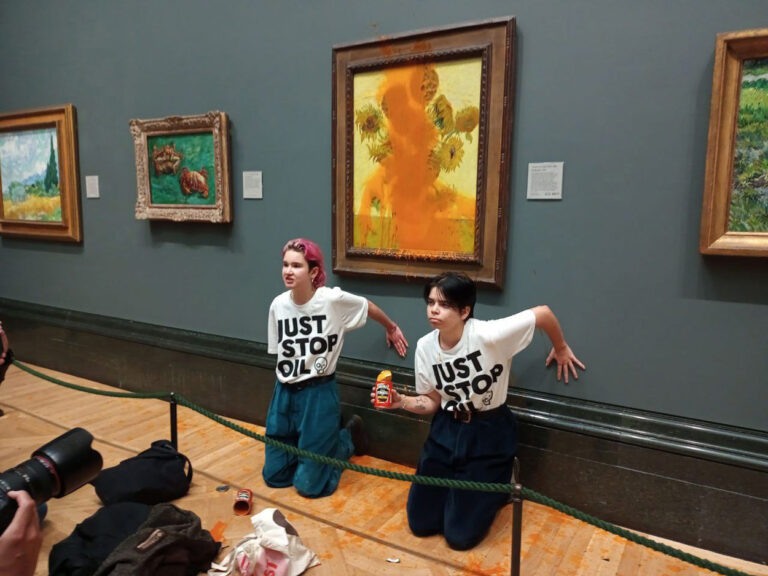Just Stop Oil, tomato soup, and Aileen Getty: How a climate protest turned into a TikTok conspiracy
Any UK-based individual who frequents the world wide web will be well aware of the latest Just Stop Oil climate protest—you know, the one that involved two cans of Heinz tomato soup. Well, this latest form of activism subsequently resulted in the short-lived birth—and death—of a wild TikTok conspiracy theory.
In case you indulged in a digital detox over the weekend, let’s do a quick recap. On Friday 14 October 2022, two Just Stop Oil activists entered the National Gallery in the heart of London armed with super glue and tomato soup. Moments later, they threw the pulpy liquid over Vincent Van Gogh’s ‘Sunflowers’ painting and proceeded to glue their hands to the wall.
In video footage of the event, one of the activists, 21-year-old Phoebe Plummer, can be heard exclaiming, “What is worth more, art or life? Is it worth more than food? More than justice? Are you more concerned about the protection of a painting or the protection of our planet and people?”
“The cost of living crisis is part of the cost of the oil crisis, fuel is unaffordable to millions of cold, hungry families. They can’t even afford to heat a tin of soup,” Plummer continued.
According to The Guardian, not long after this, Plummer and fellow activist Anna Holland were escorted out of the museum and arrested for criminal damages and aggravated trespassing. It should be noted that the painting was protected by a glass screen—a factor that Just Stop Oil claimed they took into consideration.
While shocking to some, this may appear as solely an escalation in action among a series of Just Stop Oil environmental protests that have been popping up across the capital over the past few weeks. The UK-based organisation is a coalition of different groups and, according to its website, is motivated by its primary goal which is securing a government ban of “new licences and consents for the exploration, development and production of fossil fuels in the UK.”
Just recently, the group blocked a number of major London roads—glueing themselves to the tarmac and displaying banners which call upon the government to enact a moratorium on all upcoming oil and gas projects, as reported by The Guardian.
This most recent disruption at the National Gallery, however, sent shockwaves through the ether, particularly after certain netizens began claiming that the attack on the Van Gogh painting was secretly funded by Big Oil themselves as a publicity stunt to depict climate activists as evil, malicious… and supposedly anti-art?
In a recently uploaded TikTok video that has since been removed, a woman claimed that Just Stop Oil’s latest protest is nothing more than a facade, conjured up to portray climate activists negatively. Her evidence? The fact that the environmental activist group has, in the past, received large donations from Big Oil heiress Aileen Getty, the granddaughter of industry mogul, Jean Paul Getty.
Before we venture into the debunking of this conspiracy theory, it should be noted that, on the surface, it’s not insanely far-fetched. Getty does come from a dynasty of oil, her family having been involved in the industry for over a century. Therefore, it would not be completely absurd to consider the possibility that she funded Just Stop Oil—and its most outrageous protests—in an attempt to influence public opinion.
If we take a closer look, however, we can see that this just isn’t the case. Upon a quick Google search for ‘Aileen Getty’, you almost immediately come across the Climate Emergency Fund (CEF). This organisation specialises in funding and supporting disruptive protests and activists to have a transformative impact on protecting humanity and the living world.
Getty is the founding donor of the CEF and, as reported by NPR, contributed $500,000 to kickstart the organisation. While she may have foundations in oil, the heiress has gone to extreme lengths to support the climate emergency cause. The Aileen Getty Foundation has also shifted a bulk of vital resources to different organisations—such as Just Stop Oil—and individuals who are addressing the climate emergency.
As aptly noted by TikTok user Tom Nicholas, “Aileen Getty’s well-documented and well-publicised donations to climate action groups appear to be more the result of being someone who feels guilty of where her family’s wealth has come from, rather than any kind of attempt to undermine the climate movement.”
@tom_nicholas TikTok is currently ablaze with a conspiracy theory that Just Stop Oil is funded by the fossil fuel industry. But it’s not true! #juststopoil #juststopoilprotest #conspiracy #conspirancytheory #climatechange #climateaction #climatecrisis #climatecrisistiktok #climate #politics #leftist #woketok #vangogh #sunflowers #art #tiktok #fossilfuels #debunked
♬ original sound - Tom Nicholas
Only two years ago, in 2020, The New York Times credited Getty with acknowledging her family’s past impact on climate change and for taking steps to actively remove fossil fuels from her portfolio in favour of sustainable investments.
Just Stop Oil is a tenacious coalition of activists and as long as its protest tactics continue and catch nationwide attention, I’m sure that a cohort of ‘follow-the-money’ conspiracy theories will trail right behind.






